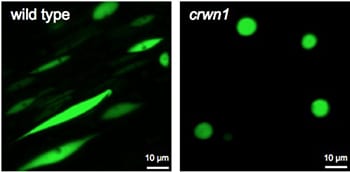News
Architecture within Plant Cells—Keeping the Genome’s House in Order

Nuclei (green) from normal (wild type, left) and mutant (crwn1, right) root cells of Arabidopsis thaliana. Image source: Travis Dittmer.
When you looked into the microscope in biology class, you may remember identifying several organelles—nucleus, vacuole, chloroplasts—floating around in the cytoplasm, but do your remember their shape?
Researchers at the Boyce Thompson Institute and Cornell University have been looking at a family of proteins, required for the proper organization of the nucleus, the most important organelle in the cell. In their recently published paper, the Richards laboratory describes a family of proteins, which controls the shape of the nucleus and how the shape may affect plant function.
The study was led by Haiyi Wang, who utilized Arabidopsis to study CRWN proteins, which refers to the small or “crowded” nuclei phenotype observed in mutant plants with a defective CRWN gene. In a previous study, the Richards laboratory identified four genes within the CRWN family. In the most recent study, Wang showed that these genes are essential for plant viability.
“CRWN proteins are required for plants to survive,” says Richards. When all four CRWN genes in Arabidopsis are inactivated, the plants are inviable. Nonetheless, plants are incredibly adaptive and often look normal when only one of the four CRWN genes is inactivated. However, when the team looked at plants with a mutation in either the CRWN1 or CRWN4 gene, they found that both the shape and size of the nucleus was altered.
“The nucleus stores the genetic material, and genes are read from this location,” says Dr. Richards. “It has been known for some time that the nucleus and the genome (the DNA) housed within it are organized in a three-dimensional structure. Within the nucleus, where a gene is stored and mRNA is transcribed is important, just as where you live is important,” describes Dr. Richards. “Your address is a point on a map and the environment you live in can change the way you interact with the world. Similarly, the location within the nucleus where a gene is stored can change the way this gene is expressed.”
In normal Arabidopsis plants, nuclei are flatter and shaped like an elongated football. However, in both crwn1 and crwn4 mutants, the nuclei are very round and significantly smaller. Additionally, regions of the genome, called heterochromatin, become disorganized and dispersed in crwn4 mutants. “Heterochromatin is like the storage boxes in your attic that you don’t access very often,” describes Dr. Richards. “Normally, heterochromatin is condensed and contains regions of DNA that are not expressed very often. These DNA sequences are packaged by other proteins and put at the edge of the nucleus. In this way, the nucleus is able to access or read genes that should always be expressed and ignore the heterochromatic genes residing at the edges of the nucleus.”
In the crwn4 mutants, the plant looks very normal, despite having abnormally shaped nuclei and dispersed heterochromatin. This speaks to the ability of plants to compensate for drastic cellular changes, but more importantly it allows us to understand basic functions of the cell. Proteins responsible for the shape and organization of the nucleus may impact the genes which control plant phenotypes—what they look like and how they might react to different environmental stresses.
In both plants and animals, the shape of the nucleus and the way the genome is organized is very similar, though plants and animals have evolved a different set of machinery to regulate these processes. The shape of the nucleus may have many implications on how genes are regulated. For example, in humans, misshapen nuclei are known to occur naturally in the aged, and similar nuclear shapes are caused by specific mutations associated with some types of premature aging syndromes (such as certain forms of Progeria). The Richards lab is using the CRWN proteins to understand how the fundamental organization of the nucleus affects the plant.
This study was published in BMC Plant Biology in December 2013 and Dr. Wang defended her doctoral dissertation on the CRWN proteins in March 2014.
The CRWN research was funded by support from the National Science Foundation and funding from the Boyce Thompson Institute’s research fund.
The full scientific article citation is:
Haiyi Wang, Travis A Dittmer, and Eric J Richards. Arabidopsis CROWDED NUCLEI (CRWN) proteins are required for nuclear size control and heterochromatin organization. BioMed Central Plant Biology 2013, 13:200. doi:10.1186/1471-2229-13-200.
Natalie Henkhaus is a PhD Candidate at Cornell University working in the Richards laboratory at the Boyce Thompson Institute.

